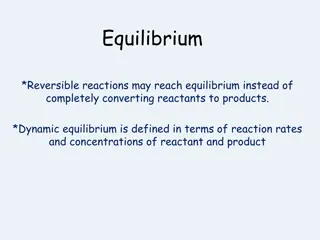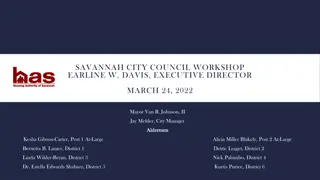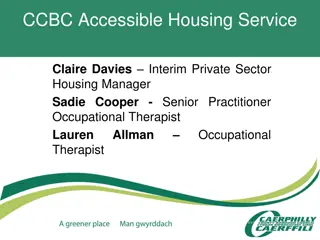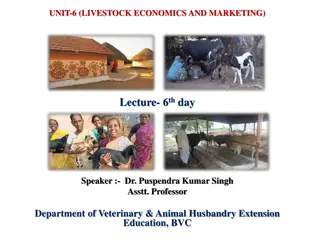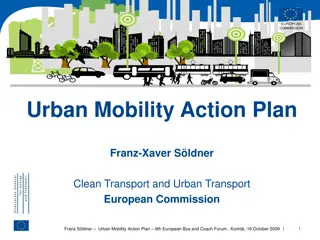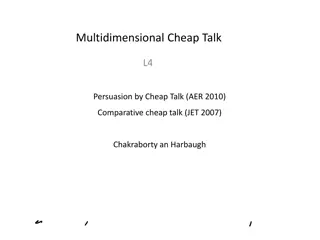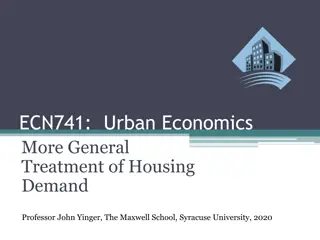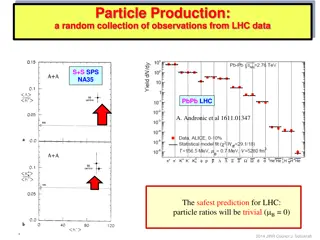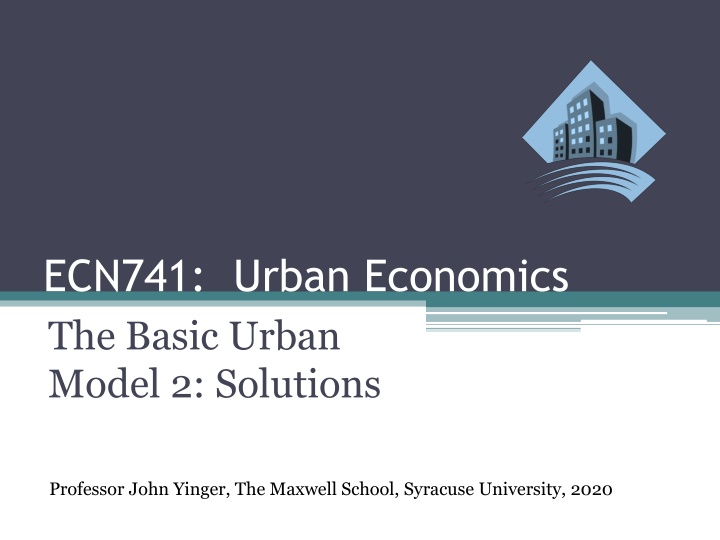
Basic Urban Model: Housing Demand and Equilibrium Analysis
Discover the fundamentals of urban economics with a focus on housing demand and equilibrium analysis. Explore key concepts such as bid functions, housing supply, and market dynamics through detailed models and equations. Dive into the optimization of household utility and economic constraints for a comprehensive understanding of urban economic dynamics.
Download Presentation

Please find below an Image/Link to download the presentation.
The content on the website is provided AS IS for your information and personal use only. It may not be sold, licensed, or shared on other websites without obtaining consent from the author. If you encounter any issues during the download, it is possible that the publisher has removed the file from their server.
You are allowed to download the files provided on this website for personal or commercial use, subject to the condition that they are used lawfully. All files are the property of their respective owners.
The content on the website is provided AS IS for your information and personal use only. It may not be sold, licensed, or shared on other websites without obtaining consent from the author.
E N D
Presentation Transcript
ECN741: Urban Economics The Basic Urban Model 2: Solutions Professor John Yinger, The Maxwell School, Syracuse University, 2020
The Basic Urban Model Class Outline 1. Motivation for Urban Models 2. Housing Demand 3. Deriving a Bid Function 4. Housing Supply 5. Anchoring Bid Functions 6. A Complete Urban Model 7. Solving Open and Closed Models
The Basic Urban Model Class Outline 1. Motivation for Urban Models 2. Housing Demand 3. Deriving a Bid Function 4. Housing Supply 5. Anchoring Bid Functions 6. A Complete Urban Model 7. Solving Open and Closed Models
The Basic Urban Model Motivation for Urban Models Urban models are built on the following simple sentence: People care about where they live because they must commute to work. This sentence contains elements of 6 markets: Housing Land Capital Transportation Labor Export good
The Basic Urban Model Motivation for Urban Models, 2 So now we are going to write down equations for these 6 markets. It is difficult to solve a general equilibrium model with 6 markets. That is why we rely on the strong assumptions discussed in the previous class. Moreover, the best way to understand a complex system is to write down a simple version and then try to make it more general. That is what we will do throughout this course.
The Basic Urban Model Class Outline 1. Motivation for Urban Models 2. Housing Demand 3. Deriving a Bid Function 4. Housing Supply 5. Anchoring Bid Functions 6. A Complete Urban Model 7. Solving Open and Closed Models
The Basic Urban Model Housing Demand A household maximizes ( ) Z H = + 1 ln ln . U Subject to P u H = + + . Y Z tu
The Basic Urban Model Housing Demand, 2 Recall from the last class that the Lagrangian for this problem is: ( , U Z H Y = + ) P u H , Z tu And the first-order conditions for Z and H imply that / / U U H Z P u = . MB H
The Basic Urban Model Housing Demand, 3 With a Cobb-Douglas utility function, U H = H and 1 U Z = Z so 1 = { } . P u H Z
The Basic Urban Model Housing Demand, 4 Now add the first-order condition with respect to : ( ) P u H = + + = 0. Y Z tu Combining results: 1 P u H + + = { } P u H 0. Y tu
The Basic Urban Model Housing Demand, 5 These conditions imply that ( P u ) Y tu = . H ( )( ) = Y tu 1 . Z These are standard Cobb-Douglas results, except that P varies with u and the income term is net of commuting costs to u.
The Basic Urban Model Class Outline 1. Motivation for Urban Models 2. Housing Demand 3. Deriving a Bid Function 4. Housing Supply 5. Anchoring Bid Functions 6. A Complete Urban Model 7. Solving Open and Closed Models
The Basic Urban Model Deriving a Bid Function A bid function, P{u}, can be derived in two different ways: The indirect utility function approach, pioneered by Robert Solow (Swedish J. of Econ., March 1972). The differential equation approach, in Alonso, Muth, Mills. The best approach depends on the context!
The Basic Urban Model The Indirect Utility Function Approach Substitute the demands for H and Z into the exponential form for the utility function: ( ) - k Y tu U = P u where ( ) 1 = 1 k
The Basic Urban Model An Aside: Transformation of Utility Functions Any positive monotonic transformation of a utility function is also a utility function that represents the same preferences. Thus, demand functions are not affected by a positive monotonic transformation of the utility function. For example, the following three utility functions yield the same demands: ln{ } U Z = = = + ln{ } H + 1 2 (1 Z )ln{ } H ln{ } H U U Z 1
The Basic Urban Model Indirect Utility Function Approach, 2 All household receive the same utility level, U*, so 1 k P u ( ) 1 = Y tu * U or P u ( ) 1 = Y tu The height of the bid function, , obviously depends on the utility level, U*.
The Basic Urban Model The Locational Equilibrium Condition Remember from last class: The price of housing adjusts so that, no matter where someone lives, savings in housing costs from moving one mile further out exactly offsets the increased commuting costs. The savings in housing costs is: P u H The increase in commuting costs is just t.
The Basic Urban Model The Differential Equation Approach Thus, the locational equilibrium condition is: t P u = H Now substitute in the demand for housing to obtain the differential equation: tu P u P u tP u Y t P u = = or . ( ) ( ) Y tu
The Basic Urban Model Differential Equation Approach, 2 This is an exact differential equation. It has the function, P{u} on one side and the argument, u, on the other. It can be solved simply by integrating both sides. The key integral is: g u g u g u = + 1n du
The Basic Urban Model Differential Equation Approach, 3 The result: 1 P u = Y tu + 1n 1n . or P u ( ) ( ) 1 1 = = e Y tu Y tu Not surprisingly, both approaches yield the same answer!
The Basic Urban Model Class Outline 1. Motivation for Urban Models 2. Housing Demand 3. Deriving a Bid Function 4. Housing Supply 5. Anchoring Bid Functions 6. A Complete Urban Model 7. Solving Open and Closed Models
The Basic Urban Model Housing Supply The housing production function is assumed to take the Cobb-Douglas form: s H u AK u = L u 1 a a where the S subscript indicates aggregate supply at location u, K is capital and L is land, both of which vary with location. Because this is a long-run model, the role of labor in housing construction is ignored.
The Basic Urban Model Input Demand Profit-maximizing firms set the value of the marginal product of each input equal to its price: ( ) K u L u 1 a P u H u = = s constant r aP u H u R u = s Note that ris the area s capital rental rate, and R{u} is rent per unit of land per unit of time at a location u miles from the CBD.
The Basic Urban Model Note on Land Prices Note that the demand for land is a derived demand. In residential use, the price of land is determined by the price of housing. Land at a given location has value because someone is willing to pay for housing there. It is not correct to say that someone has to pay a lot for housing because the price of land is high!
The Basic Urban Model Solving for R{u} Now solve the input market conditions for K{u} and L{u} and plug the results into the production function: a ( ) a P u H u r R u 1 a 1 aP u H u = s s H u A s P u H u R u a 1 a 1 a = s a . Aa r
The Basic Urban Model Solving for R{u}, 2 Now HS{u} obviously cancels and we can solve for: R u R u = a = ( CP u or ) 1 a CP u where 1 a 1 a = a C Aa r
The Basic Urban Model Solving for R{u}, 3 Combining this result with the earlier result for P{u}: ( ( Y = ) 1 a R u ( ) 1 = 1 a C Y tu ) 1 a * tu The exponent in this function reflects both the share of housing in the utility function ( ) and the share of land in the production function (a). (Look carefully to tell them apart!)
The Basic Urban Model Solving for R{u}, 4 Because and a are fractions, the exponent for income net of commuting costs is larger (and the curvature of the equation is greater) in the R{u} equation than in the P{u} equation. The curvature in the P{u} equation reflects the substitution of Z for H in consumption as the price of H goes up. The curvature in the R{u} equation reflects not only this substitution in consumption, but also the substitution of capital for land in housing production as the price of land goes up.
The Basic Urban Model Class Outline 1. Motivation for Urban Models 2. Housing Demand 3. Deriving a Bid Function 4. Housing Supply 5. Anchoring Bid Functions 6. A Complete Urban Model 7. Solving Open and Closed Models
The Basic Urban Model Anchoring R{u} Recall that we have derived families of bid functions, P{u} and R{u}. The easiest way to anchor them, that is, to pick a member of the family, is by introducing the agricultural rental rate, , and the outer edge of the urban area, : R u R u = . R
The Basic Urban Model Determining the Outer Edge of the Urban Area R{u} _ R _ u u CBD
The Basic Urban Model Anchoring R{u}, 2 This outer-edge condition can be substituted into the above expression for R{u} to obtain: R = * ( ) 1 a 1 a C Y tu With this constant, we find that 1 a Y Y tu tu R u = R
The Basic Urban Model Anchoring P{u} Now using the relationship between R{u} and P{u}, 1 Y Y tu tu P u = P where the opportunity cost of housing is a R C = P
The Basic Urban Model Questions What are the two methods for deriving a bid function? How is a bid function anchored? How is the price of land determined?
The Basic Urban Model Class Outline 1. Motivation for Urban Models 2. Housing Demand 3. Deriving a Bid Function 4. Housing Supply 5. Anchoring Bid Functions 6. A Complete Urban Model 7. Solving Open and Closed Models
The Basic Urban Model A Complete Urban Model So now we can pull equations together for the 6 markets Housing Land Capital Transportation Labor Export Good
The Basic Urban Model Housing ( Y P u AK u ) Demand: tu = H Supply: u L u 1 a a = H s D = S: = { } { } N u H u { } H u S where N{u} is the number of households living at location u.
The Basic Urban Model Land Demand: L u u aP u H R u = s Supply: L u = . u [Ownership: Rents go to absentee landlords.]
The Basic Urban Model The Capital Market Demand: ( ) a P u H K u u 1 = s r Supply: r is constant
The Basic Urban Model The Transportation Market T{u} = tu = (t0 + tYY)u Commuting cost per mile, t, does not depend on Direction Mode Road Capacity Number of Commuters. These assumptions imply circular iso-commuting-cost lines and a circular city.
The Basic Urban Model Labor and Goods Markets All jobs are in the CBD (with no unemployment). The CBD takes up no space (to be fixed later!) Wage and hours worked are constant, producing income Y. This is consistent with perfectly elastic demand for workers derived from export-good production. Each household has one worker.
The Basic Urban Model Labor and Goods Markets, 2 N{u} is the number of households living a location u. The total number of jobs is N. So _ u = . N u du N 0
The Basic Urban Model Locational Equilibrium The bid function 1 k P u ( ) 1 = Y tu * U The anchoring condition R u = . R
The Basic Urban Model The Complete Model The complete model contains 10 unknowns: u H{u}, HS{u}, L{u}, K{u}, N{u}, P{u}, R{u}, N, , and U* It also contains 9 equations: (1) Housing demand, (2) housing supply, (3) housing S=D, (4) capital demand, (5) land demand, (6) land supply, (7) labor adding-up condition, (8) bid function, (9) anchoring condition.
The Basic Urban Model The Complete Model, 2 Note that 7 of the 10 variables in the model are actually functions of u. An urban model is designed to determine the residential spatial structure of an urban area, so the solutions vary over space. In the basic model there is, of course, only one spatial dimension, u, but we will later consider more complex models.
The Basic Urban Model Questions How are the labor market and the product market simplified? How is an urban model linked to the map of an urban area?
The Basic Urban Model Class Outline 1. Motivation for Urban Models 2. Housing Demand 3. Deriving a Bid Function 4. Housing Supply 5. Anchoring Bid Functions 6. A Complete Urban Model 7. Solving Open and Closed Models
The Basic Urban Model Open and Closed Models It is not generally possible to solve a model with 9 equations and 10 unknowns. So urban economists have two choices: Open Models: Assume U* is fixed and solve for N. Closed Models: Assume N is fixed and solve for U*.
The Basic Urban Model Open and Closed Models, 2 Open models implicitly assume that an urban area is in a system of areas and that people are mobile across areas. Household mobility ensures that U* is constant in the system of areas (just as within-area mobility holds U* fixed within an area). Closed models implicitly assume either (1) that population is fixed and across-area mobility is impossible, or (2) that any changes being analyzed affect all urban areas equally, so that nobody is given an incentive to change areas.
The Basic Urban Model Solving a Closed Model The trick to solving the model is to go through N{u}= HS{u}/H{u}. Start with the housing S=D and plug in expressions for H{u} and HS{u}. For H{u}, use the demand function, but put in P{u}=R{u}a/C. For HS{u}, plug K{u} (from its demand function) and the above expression for P{u}into the housing production function.





